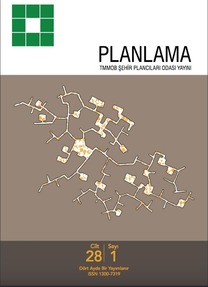Piyasa Koşullarında Kentsel Sit Kararının Taşınmaz Değeri Üzerindeki Etkileri: Talas (Kayseri) Örneği The Effects of Conservation Registration Status on
The Effects of Conservation Registration Status on Real Estate Market Values on Talas (Kayseri) Case
___
- Aliefendioğlu, Y. (2011). Türkiye’de Koruma Alanlarındaki Taşınmazların Kullanımı ve Koruma Statülerinin Taşınmaz Piyasaları ve Değerlerine Etkileri: Muğla İli Örneği (Doktora tezi). Ankara Üniversitesi/Fen Bilimleri Enstitüsü, Ankara.
- Alkay, E. (2002). Hedonik Fiyat Yöntemi ile Kentsel Yeşil Alanların Ekonomik Değerlerinin Ölçülmesi (Doktora Tezi). İ.T.Ü./Fen Bilimleri Enstitüsü, İstanbul
- Asabere, P. K., Huffman, F. E., Mehdian, S. (1994). The Adverse Impacts of Local Historic Designation: The Case of Small Apartment Buildings in Philadelphia. The Journal of Real Estate Finance and Economics, 8, 225–234.
- Ashworth, G. J. (2002). Conservation Designation and the Revaluation of Property: The Risk of Heritage Innovation. International Journal of Heritage Studies, 8 (1), 9-23
- Çakır, P., Sesli, F. A. (2013). Arsa Vasıflı Taşınmazların Değerine Etki Eden Faktörlerin ve Bu Faktörlerin Önem Sıralarının Belirlenmesi. Harita Teknolojileri Elektronik Dergisi, 5 (3), 1-16.
- Cebula, R. J. (2009). The Hedonic Pricing Model Applied to the Housing Market of the City of Savannah and Its Savannah Historic Landmark District. The Review of Regional Studies, 39, 9–22.
- Eichengreen, B. (1997). Economics and Culture in the Writing of Financial History. Washington, DC: Departments of Economics and Political Science University of California, Berkeley Research Department International Monetary Fund
- Erdem, N. (2016). Türkiye İçin Bir Taşınmaz Değerleme Sistemi Yaklaşımı (Yüksek Lisans Tezi). Erciyes Üniversitesi/Fen Bilimleri Enstitüsü. Kayseri.
- Heintzelman, M. D., Altieri, J. A. (2013). Historic Preservation: Preserving Value? The Journal of Real Estate Finance and Economics, 46, 543–563.
- Klamer, A., Zuidhof, P.W. (1998). The Role of the Third Sphere in the World of the Arts, XX Conference of the Association of Cultural Economics International, Barcelona.
- Lazrak, F., Nijkamp, P., Rietveld, P., Rouwendal, J. (2014). The Market Value of Cultural Heritage in Urban Areas: An Application of Spatial Hedonic Pricing. Journal of Geographical Systems, 16, 89–114.
- Leichenko, R. M., Coulson, N. E., Listokin, D. (2001). Historic Preservation and Residential Property Values: An Analysis of Texas Cities. Urban Studies, 38 (11), 1973–1987
- Licciardi, G., Amirtahmasebi, R. (Ed.). (2012). The Economics of Uniqueness – Investing in Historic City Cores and Cultural Heritage Assets for Sustainable Development. Washington, DC: The World Bank.
- Lichfield, N. (1988). Economics in Urban Conservation, Cambridge: Cambridge University Press
- Lichfield, N. (1997). Cultural Built Heritage in Community Impact Evaluation, London: UCL Press
- Nas, B. B. (2011). YSA ve DVM Yöntemleri ile Taşınmaz Değerlemesi İçin Bir Yaklaşım Geliştirme. (Yüksek Lisans Tezi). Selçuk Üniversitesi/Fen Bilimleri Enstitüsü, Konya
- Nişancı, N. (2005). Coğrafi Bilgi Sistemi ile Nominal Değerleme Yöntemine Dayalı Piksel Tabanlı Kentsel Taşınmaz Değer Haritalarının Üretilmesi. (Doktora Tezi). K.T.Ü./Fen Bilimleri Enstitüsü, Trabzon
- Noonan, D. S. (2013). Market Effects of Historic Preservation. I. Rizzo, A. Mignosa (Ed.), Handbook on the Economics of Cultural Heritage içinde (s. 344–363). Cheltenham: Edward Elgar Publishing.
- Noonan, D. S., Krupka, D. J. (2011). Making – or picking – Winners: Evidence of Internal and External Price Effects in Historic Preservation Policies. Real Estate Economics, 39, 379–407.
- Noonan, D.S., Krupka D. J. (2008). Determinants of Historic and Cultural Landmark Designation: Why We Preserve What We Preserve, Bonn: Georgia Institute of Technology, IZA Discussion Paper No. 3777
- Nuhoğlu, B. A. (2007). Gayrimenkul Değerleme. (Yüksek Lisans Tezi). Ondokuz Mayıs Üniversitesi/Fen Bilimleri Enstitüsü, Samsun.
- Ost, C. (2010). Heritage in Historic Cities: Economic and Strategic Analysis, Damascus: UNESCO Euromed Heritage Strengthening of Institutional, and Legal Framework, Ministry of Culture Syrıa, Euromed, Workshop.
- Ökten, A. E. (2012) Tarihi Konut Yapılarını ve Alanlarını Korumanın Ekonomik Etkilerinin Değerlendirilmesi-Galata Örneği. (Doktora Tezi). İ.T.Ü./Fen Bilimleri Enstitüsü, İstanbul
- Özer, M. (2010). Taşınmaz Değerlemesinde Kullanılan Finansal ve Sayısal Yöntemler: Topsis ve Yeni Çoklu Kriter Modelleriyle Bir Uygulama. (Yüksek Lisans Tezi). Dokuz Eylül Üniversitesi/Sosyal Bilimler Enstitüsü, İzmir.
- Tanrıvermiş, H. (2016). Gayrimenkul Değerleme Esasları. Ankara: Lisanslama Sınavları Çalışma Kitapları. erişim https://docplayer.biz. tr/15973700-Gayrimenkul-degerleme-esaslari.html
- Thompson, E., Rosenbaum, D., Schmitz, B. (2011). Property Values on the Plains: The Impact of Historic Preservation. The Annals of Regional Science, 47, 477–491.
- Yalpır, Ş. (2007). Bulanık Mantık Metodolojisi ile Taşınmaz Değerleme Modelinin Geliştirilmesi ve Uygulaması: Konya Örneği. (Doktora Tezi). Selçuk Üniversitesi/Fen Bilimleri Enstitüsü, Konya
- Yıldırım, E. (2005). Gayrimenkul Değerleme Esasları. İstanbul: Bilgi Üniversitesi Seminer Notları.
- Yılmaz, N. (2005). Kent Merkezlerindeki Kentsel Sit Alanlarında Değişim Sürecinin Değerlendirilmesi. (Yüksek Lisans Tezi). İ.T.Ü./Fen Bilimleri Enstitüsü, İstanbul.
- Yomralıoğlu, T. (1993). The Investigation of a Value-Based Urban Land Readjustment Model and Its Implementation Using Geographical Information Systems. (Doktora Tezi). University of Newcastle Upon Tyne, Newcastle.
- Yomralıoğlu, T. (1997). Taşınmaz Değerlendirilmesi ve Kat Mülkiyeti Mevzuatı. JEFOD-Kentsel Alan Düzenlemelerinde İmar Planı Uygulama Teknikleri, 153-169. erişim https://web.itu.edu.tr/tahsin/Arsiv/tahsin/ Yayn_MakaleTR_files/74_05.pdf
- ISSN: 1300-7319
- Yayın Aralığı: Yılda 3 Sayı
- Başlangıç: 1986
- Yayıncı: TMMOB Şehir Plancıları Odası
İklim Değişikliğine Uyumda Mekânsal Planlama ve Akıllı Yönetişim Çerçevesinde Türkiye
A Review of the Environmental Sustainability History of the World and Turkey
Çevresel Sürdürülebilirliğin Dünya ve Türkiye'deki Tarihine Dair Bir İnceleme
Endüstriyel-Kültürel Mirasın Değerlendirilmesi: Almanya Zollverein Maden Ocağı Kompleksi Örneği
Sakin Şehir Markalaşmasının Kentsel Mekâna Etkilerinin İncelenmesi: Sığacık Örneği
Dalya Hazar Kalonya, Görkem Gülhan, Aysun Aygün
Mehmet EROĞLU, Aslı Öğüt ERBİL
Kentsel Dönüşümün Modern Bir Konut Alanı Üzerindeki Etkileri: Talimhane, İstanbul Örneği
Elifnaz DURUSOY ÖZMEN, Ebru OMAY POLAT
Rüzgârdan Enerji Üretiminin Sosyo-Mekânsal Duyarlılık Alanları: İzmir Örneği
Konya Kentsel Alanının Büyümesinde Kentsel Saçaklanma ve Nedenleri
